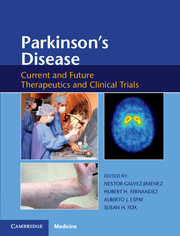Book contents
- Parkinson's DiseaseCurrent and Future Therapeutics and Clinical Trials
- Parkinson's Disease
- Copyright page
- Contents
- Contributors
- Book part
- Section I The Pharmacological Basis for Parkinson's Disease Treatment
- Section II Management of Nonmotor Symptoms of Parkinson's Disease
- Section III Surgical Management of Parkinson's Disease
- Section IV Clinical Trials in Parkinson's Diease: Lessons, Controversies and Challenges
- Index
- References
Section IV - Clinical Trials in Parkinson's Diease: Lessons, Controversies and Challenges
Published online by Cambridge University Press: 05 March 2016
- Parkinson's DiseaseCurrent and Future Therapeutics and Clinical Trials
- Parkinson's Disease
- Copyright page
- Contents
- Contributors
- Book part
- Section I The Pharmacological Basis for Parkinson's Disease Treatment
- Section II Management of Nonmotor Symptoms of Parkinson's Disease
- Section III Surgical Management of Parkinson's Disease
- Section IV Clinical Trials in Parkinson's Diease: Lessons, Controversies and Challenges
- Index
- References
- Type
- Chapter
- Information
- Parkinson's DiseaseCurrent and Future Therapeutics and Clinical Trials, pp. 231 - 360Publisher: Cambridge University PressPrint publication year: 2016

